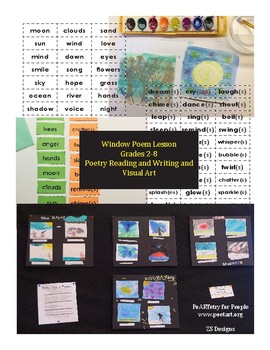Window Poem Lesson: Reading and Writing Poetry and Creating Poetart!
ZS Designs
6 Followers
Grade Levels
2nd - 8th
Subjects
Resource Type
Standards
CCSSRL.2.4
CCSSRL.6.1
CCSSRL.6.4
CCSSRL.6.10
CCSSW.6.10
Formats Included
- PDF
Pages
13 pages
ZS Designs
6 Followers
Description
This is a fun and thought-provoking lesson designed to engage students with poetry and the creative process. A detailed lesson plan, resource materials, and a PDF that lists the Common Core State Standards met by the lesson for grades 2 through 8 are included. Students learn about the poetic device "personification" while producing original poems that are enriched by a visual arts project that relates to their written words. The completed artworks provide windows through which everyday things can be perceived in new ways. An abbreviated version of this lesson can also be found on the author's website PoARTetry for People (www.poetart.org) under the blog tab.
Total Pages
13 pages
Answer Key
N/A
Teaching Duration
3 days
Report this resource to TPT
Reported resources will be reviewed by our team. Report this resource to let us know if this resource violates TPT’s content guidelines.
Standards
to see state-specific standards (only available in the US).
CCSSRL.2.4
Describe how words and phrases (e.g., regular beats, alliteration, rhymes, repeated lines) supply rhythm and meaning in a story, poem, or song.
CCSSRL.6.1
Cite textual evidence to support analysis of what the text says explicitly as well as inferences drawn from the text.
CCSSRL.6.4
Determine the meaning of words and phrases as they are used in a text, including figurative and connotative meanings; analyze the impact of a specific word choice on meaning and tone.
CCSSRL.6.10
By the end of the year, read and comprehend literature, including stories, dramas, and poems, in the grades 6–8 text complexity band proficiently, with scaffolding as needed at the high end of the range.
CCSSW.6.10
Write routinely over extended time frames (time for research, reflection, and revision) and shorter time frames (a single sitting or a day or two) for a range of discipline-specific tasks, purposes, and audiences.





